A glimpse into the past...
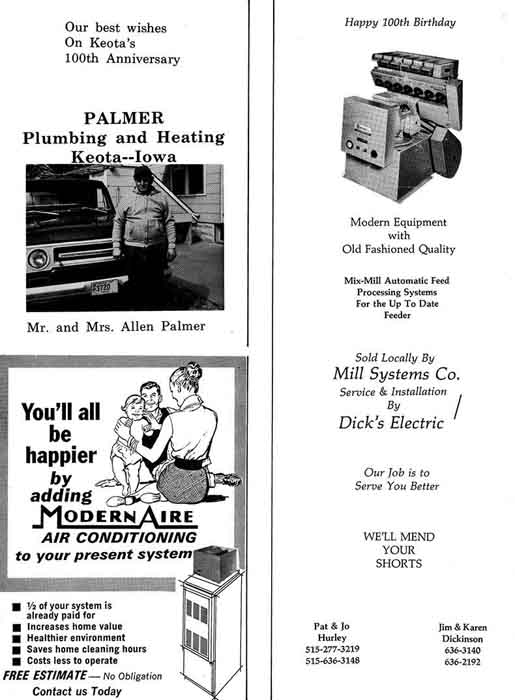
91
A glimpse into the past...
KEISER BROTHERS
IMPORTERS AND BREEDERS OF DRAFT STALLIONS
November 19,
1897. Keiser Brothers are getting their quarters on East Broadway in
shape for the doing of an extensive business in handling of horses.
July 1899. Keiser
Brothers' importation of 26 horses is here. Five or six are English
Sires, one is an English Hackney, one is a French Coach and the rest
Percherons.
December 20.
1900. The draft horse is distinct and apart from all. He bears the
brunt of the universe's work. He put his strong shoulder to the
ponderous wheel of the world's great labor and moves it with his giant
strength. He is wholly a worker. Agriculture as it exists here, depends
greatly upon this noble animal. As the years crowd on and affairs of
mankind grow more complex, the draft horse becomes more and more
indispensable. His help and value are more appreciated and the demand
for him increases.
With the
understanding of these conditions the firm of Keiser Brothers has grown
in the importation of the Draft Horse. Samuel I. Keiser, the senior
member of the firm, is an experienced horseman with a record of 19
years of service in the work. He has made nine trips to Europe, being a
rare judge, shrewd buyer and clever salesman. He was selected by the
Percheron Society to act as one of the judges at the International Live
Stock Show, December 1, 1900.
Charles O. Keiser
is the junior member of the firm. He has studied the make up of the
drafter until he has mastered it thoroughly. He looks after routine
office work and road work as well and in a year's time covers a lot of
territory.
HAMILTON
BROTHERS
HORSE TRAINING STABLES
August 22, 1907.
Ralph Hamilton probably handles more saddle horses than anyone else in
Iowa. He also is an expert in riding and training them as well as a
judge in horse shows.
April 14, 1910.
Hamilton Brothers and Dave Teuscher have an expert horse jockey and
trainer, Luther Rogers from Mexico, Missouri.
March 23, 1911.
Hamilton Brothers sold their team of white Arabian horses to Iowa City
for use in the fire department of that town. They are six years old and
weigh about 1300 pounds each and are beautiful.
April 27, 1911.
The Hamilton boys have a fine pedigreed saddle stallion, bought in
Missouri. His name is Rex Lears, black as a crow, three years old and
has a gentle disposition. In Missouri everybody rides horseback. We'd
like to see the custom established here and hope Hamilton Brothers may
prove pioneers in the movement.
October 2, 1912.
Hamilton Brothers have a three decked show case full of their ribbons,
silver cups, photographs, etc., all in relation to their horse
business, on display in Boyd Smith's drug store.
July 17, 1913.
Hamilton Bros. horses at North English the Fourth was one of the best
features of the day. The bay mare and white stallion were the stars in
the things horses could be trained to do. The horses are gaited and
showed their ability to change their gait at the will of the riders.
December 18,
1913. Horse Raisers. Bring your colts to Hamilton Bros. training
stables and have them thoroughly broke to ride or drive. Gaited to suit
your taste by experienced trainers.
April 15, 1915.
Hamilton Brothers sold their fancy white harness and high school mare
to a wealthy New York man for $800 and shipped her by express. Ralph
thinks the mare may form one of the celebrated Vanderbilt strain of
show horses.
May 26, 1915. The
famous high school horse, Topsy McDonald, was exhibited at an
educational feature at Ames College, Wednesday of last week. "The Ames
Daily" had this to say — "Following the parade downtown the stock show
was held on the grounds. Prizes were awarded. Probably the feature of
the entire show was the exhibition of the high school horse, "Topsy",
owned by Hamilton Brothers, the well-known saddle and driving horsemen
of Keota, Iowa. Don Revis who trained the horse, did the riding and put
the prize winner through all sorts of stunts from the "tango" to the
"hesitation." Few circuses offer a better attraction than this."
July 1, 1915.
Hamilton's high school mare "Topsy McDonald" which they exhibited
before the South Shore Country Club won first in Class 6.
March 30, 1933.
Ralph C. Hamilton and brother John Hamilton were in the fancy saddle
horse business here and were as famous all over the country for saddle
horses as Singmasters were for draft horses. Ralph was also noted as a
judge of saddle horses and traveled to far parts of the country to
serve as judge at many important horse shows. He died in 1933.
December 31,
1936. Don Revis, who was employed by Hamilton Brothers, Keota, Iowa,
breeders of fine saddle horses before the war, is teaching Shirley
Temple to ride. The pony was given to Shirley as a gift.
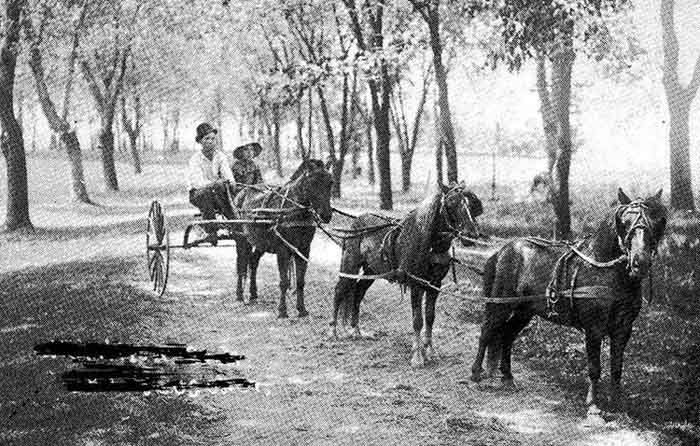
92
A glimpse into the past...
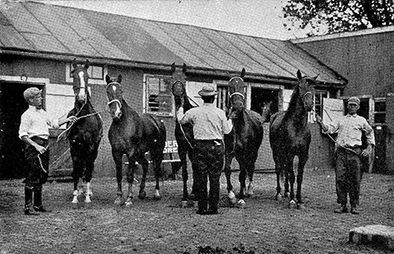
Hamilton's Horses. Sid McDonald is at the right in picture. |
THE RIVER PRODUCTS QUARRY
The River
Products quarry is located one and one half mile south of Keota on the
County Line Road. The land on which the quarry is located had been
owned by the Cady family for 70 years (1873) before the present owner
(Harold Pepper) bought the place in the fall of 1943. The Pepper family
lived on the place 17 years before they purchased it.
Slabs of
limestone were removed from the site of this quarry during the early
years of Keota when some of the buildings that now stand along Broadway
were being erected. The limestone was used in the basement walls and
for the foundations.
The quarry
then lay idle until 1932 when a group of WPA workers from Keota were
employed there. Their tools were picks and shovels and the dirt was
removed with wheel barrows.
Ed Wahl of
Victor, Iowa, moved a crusher to the location in 1935. During the
summer months of that year many tons of crushed rock were produced and
used for road constructions.
Again the
quarry lay idle until 1958 when Don Hayes of Grace Hill, after
determining the depth of the layers of stone, leased the site and moved
in big machinery to operate on a large scale. This continued for
several years when he then sold to Dillon Stone Company. They in turn
sold the business and equipment to River Products of Iowa City, Iowa.
Many kinds and qualities of crushed limestone are produced in this
quarry as well as agricultural lime.
|
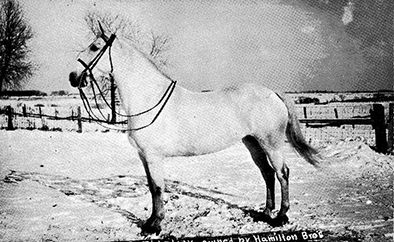
"Miss Fidelity"
Owned by Hamilton Bros. |
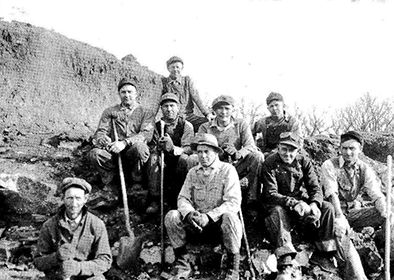
1932. W.P.A. workers at the quarry. |
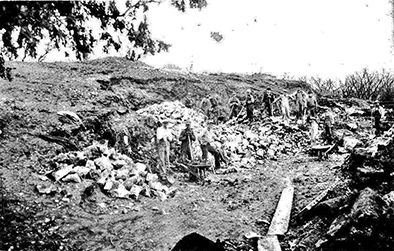 |
93
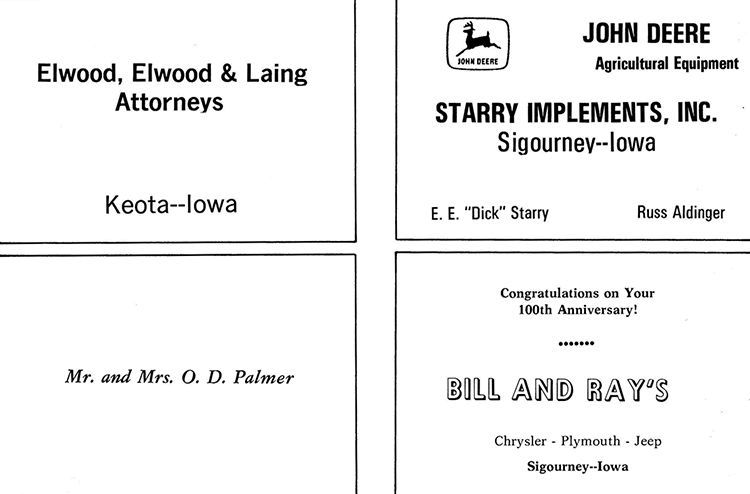
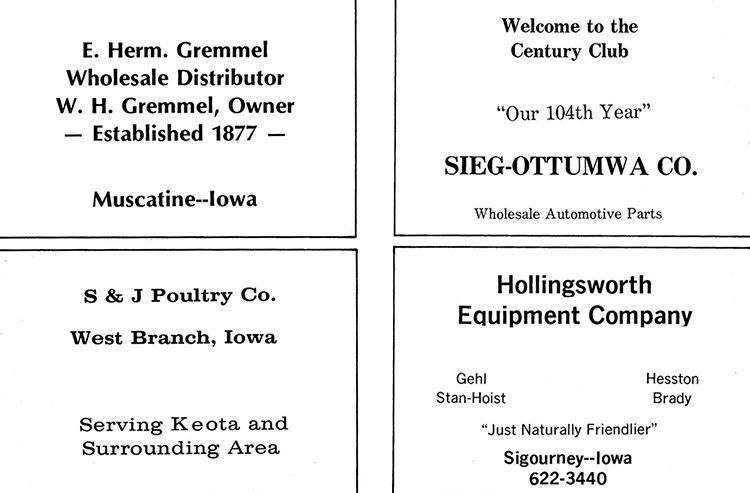
94
A glimpse into the past...
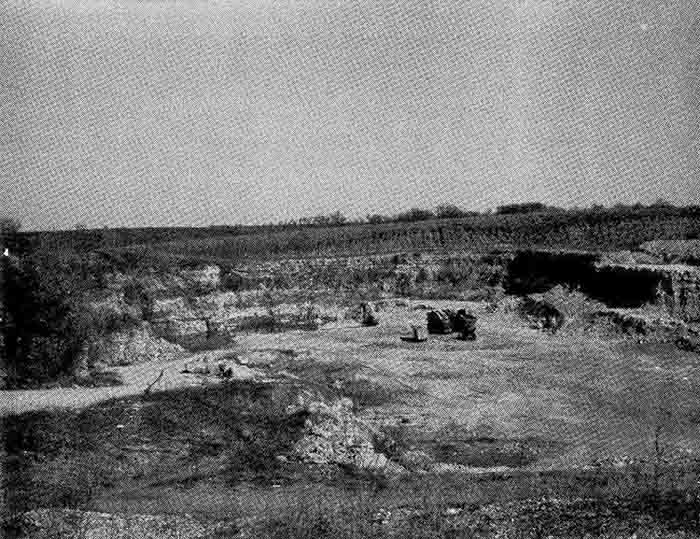
View at the quarry in 1973.
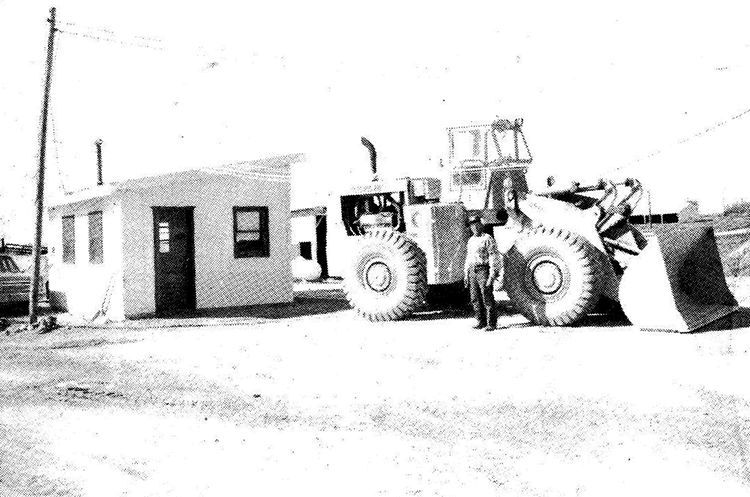
Leroy Lillig at work at the quarry in 1973.
VITTETOE
SLAT FLOORING, INC.
Vittetoe Slat
Flooring, Inc., was a business started by Mr. and Mrs. Francis
Vittetoe. The origin of the company dates back in 1960. At that time
the Vittetoes started making and using slats in various types of
livestock buildings, at first on their own farm and then they began
selling them on a small scale to others to see the results. The product
seemed to be basically good so with improvements and changes over a
period of time it worked well as a labor saver in raising hogs.
In 1965 the
product was patented. Since it was different in the fact that it was a
self-cleaning slat in the type movement it had within each slat. The
slat flooring was further improved and specific size units were made to
fit easily into all farrowing crates. This change created a greater
market and sales began growing at a greater rate. The product is now
manufactured on the Vittetoe farm one mile south of Keota. A small shop
is set up there and additional equipment is available to complete the
various type hog set ups.
MINK
INDUSTRY
In 1952 mink
became a business in Keota, Iowa. Ed Conrad and his two youngest sons,
Donald and Ronald, started a partnership called " E. L. Conrad and Sons
Mink Farm." They located on the home farm, one mile north and one and a
quarter mile east of town. As each of the sons finished high school in
the early 1950's, they took a wider interest in the business and
expanded a 300 female and 50 male herd to 1,200 females and 200 males,
as it is today.
As the business
grew, the ideas of mink ranching modernized too. The fellows built
sheds to cover their animals. This helped make chores easier to handle
and protects pens from damage by rain, snow and ice. They built up a
quality herd of pastels and mutations. They learned their business by
helping at other fur farms in Iowa during the different cycles of
producing the animals. They also participated in showing their
livestock at Exhibitions in Iowa, Minnesota , Michigan, Ohio and on to
the International Show in Milwaukee, Wisconsin. They took second high
points at the International in 1963-1964. In 1963 son Ron left the
partnership to become a CPA.
The ranch
produces approximately 9,000 pelts per year. They are skinned and dried
at the ranch, then they are shipped to New York to be sold at auction.
The partnership
has entered into the pet business and has a Federal Licensed kennel.
KEOTA
CHEMICAL, INC.
Keota Chemical,
Inc., was originated in March 1965 by Dan Osweiler, Talbert "Buzzy"
Tadlock, Robert Carris and Ray Eakins. The original name was "Tadlock
& Osweiler , Spray Division, Inc." The first year Bob and Ray
operated two Hagie sprayers, doing custom spraying in the Keota area.
In 1967, lots
were purchased and a building put up at the present location on East
Broadway. An addition was built in 1970 on the north end of the
building. The corporation has grown over the past eight years.
The name was
changed to Keota Chemical, Inc., by the current owners, Ray Eakins an d
Robert Carris. Keota Chemical is engaged in custom agricultural
spraying, lime spreading, fertilizer spreading and shop work. They do
local repair work, manufacture disc markers, conveyors and so some
contract manufacturing. They employ seven full-time men and seasonal
part-time help.
95
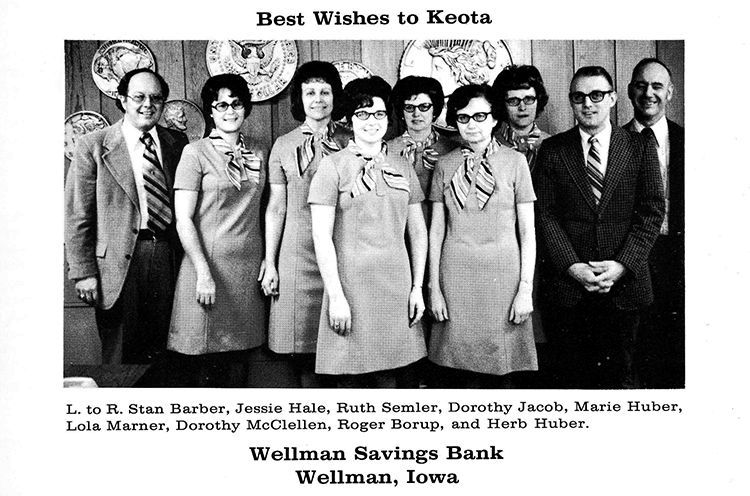
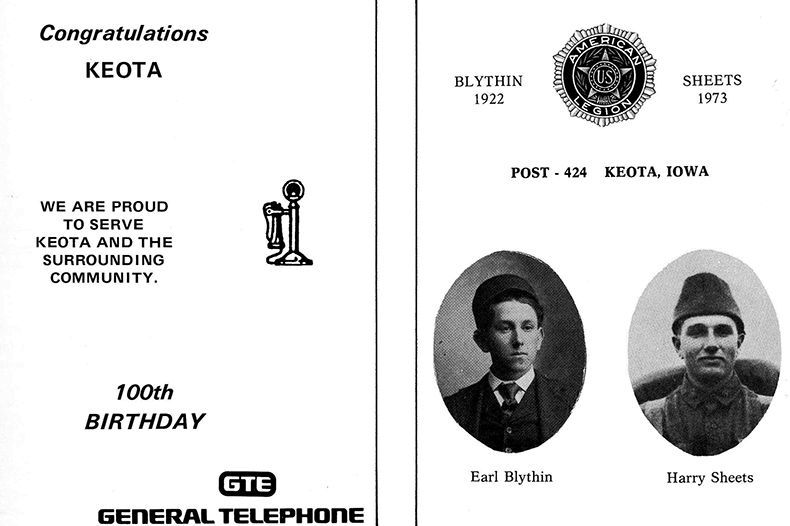
96
A glimpse into the past...
|
SEED CORN
AT WALDEN FARM
The seed
corn business at Walden Farm didn't "just happen." In the family
history book compiled by Charles D. Kirkpatrick in the past few years
many pages are devoted to the developing farm program. There was a
Field Day in 1926, sponsored by the Farm Bureau and the Iowa Extension
Service. There are two certificates attesting to first place yield
contests for corn growing in 1926 and 1927. In January of 1927, C. D.
Kirkpatrick was pictured in the first class of Master Farmers by the
farm magazine "Wallaces Farmer." He is the only member of that first
group of 14 who is still living, and has attended many of the Master
Farmer meetings through the years.
In 1936
Lester Pfister of El Paso, Illinois, offered a contract to grow Hybrid
Seed Corn, and it was accepted. This involved building a dryer, and
before long the volume of business required four dryers. In early
stages of the business Will and Frank Klein were involved in financing
and crop production. Omar J. Stoutner was also a partner in production
and sales. In 1939, 149 customers made official records of more than
100 bushels per acre in the Iowa Yield Test. Harold Palmer, using
Pfister seed grown by Walden Farm, made a record of 157.61 bushels per
acre. On November 7, 1939, 555 guests attended the corn banquet in the
Keota High School gym to honor the customers of Walden Farm who made
the l00-bushel yield records. Thirty-four of these were on farms in
Lafayette Township.
This
celebration was well advertised, given radio coverage that was not so
common as it is today. It was written up in various papers such as the
Des Moines Register and featured in Wallaces Farmer.
On March 2,
1943, Mr. Pfister sold foundation seed to contract growers with terms
which allowed them to operate as a separate corporation. Charles D.
Kirkpatrick was elected to the Board of Directors. On July 28, 1948,
the parttime detasselers and the regular employees together numbered
106 people on the Walden Farm payroll. The amount of mail that went out
from Walden Farm through the Keota Post Office was probably larger than
any other business in town.
C. D.
Kirkpatrick was a great believer in "printer's ink." During the years
of the seed business he put out a small paper, the Walden Farm News,
which was printed by The Keota Eagle. Over the years he wrote many
articles for Wallaces Farmer, newspapers, and special interest
publications, such as the hog paper, "Inbred News."
In 1949 the
seed corn business was sold to the Pfister Associated Growers
Corporation.
|
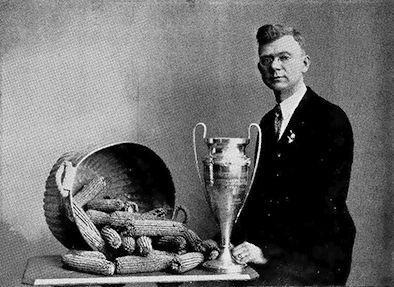
Charles D. Kirkpatrick, 1918 State Yield Test. |
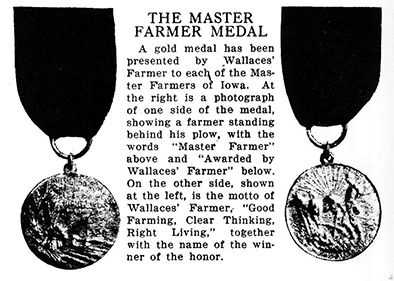 |
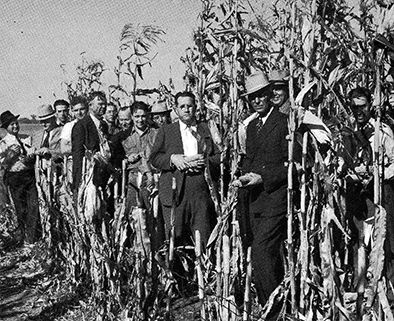
Keota business men at Walden Farm. |
97
A glimpse into the past...

At Walden Farm. |
HE IS JUST
GETTING STARTED
R. S.
Kirkpatrick, Iowa
Mr.
Kirkpatrick never threaded a loom or threw a shuttle until about six
years ago. Now he has been obliged to give up milking the cows in order
to put in more time at his principal business as a weaver. He was only
86 years of age when he started weaving—92 last June. Folks in his home
town call him Grandpa—until they see how steady he can hold a needle
and how slick he can thread it. Sew! Dear reader, you never met any
body who can hold a candle to Grandpa Kirkpatrick when it comes to
sewing carpet rags.
Now just
take a quick look at the threading of his loom. Can you do a better job
than that? We still find it hard to believe that weaving is only a
hobby with any body who can do a job like that. It looks like real
business.
From "The
Shuttle" Fall 1949
|
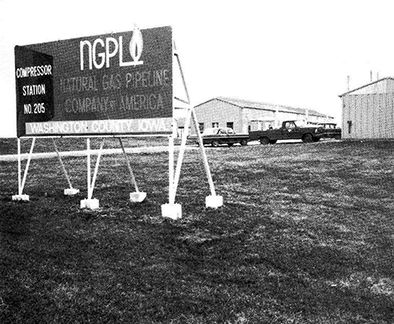
A700 horsepower compressor engine for N.G.P. Company's underground
storage facilities, two miles east of Keota, at Station 205,
arrived October 19, 1969. The huge engine weighs 58,000 pounds
and will be used to pump natural gas from the underground storage
dome into the main line during the winter's peak loads. |
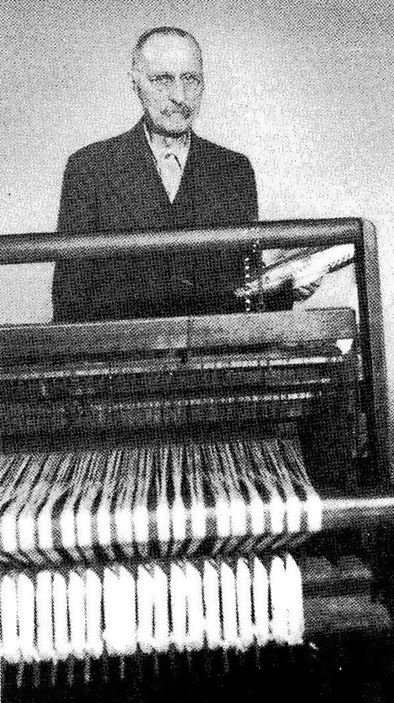
R. S. Kirkpatrick, Keota, Ia. |
98

99
A glimpse into the past...
HISTORY OF
EARLY KEOTA LIBRARIES
FROM QUOTES IN THE EARLY FILES
OF THE KEOTA EAGLE
May 12, 1877. The
last library entertainment was fairly attended. The library now has 100
volumes. Mrs. Bowland is librarian and keeps the books at Bowland's
Boot and Shoe Store, West Broadway. Call only on Friday afternoon of
each week for books.
November 17,
1877. The Library Society entertained to a full house—admission 10
cents. Enough money was cleared to buy a book or two. Everyone should
join the society-costs one dollar a year.
May 18, 1879. At
request of businessmen of Keota a meeting will be held at Kulp Hall in
reference to establishing a reading room in Keota. Let us establish a
place where our young men can spend their evenings with pleasure and
profit, without endangering their morals.
December 17,
1881. A library is something the people of every community should take
an interest in. We have a small library here that has not received the
encouragement and support it should, from the people of this town. Our
library consists of some 400 volumes. The present officers of the
library complain that not enough interest is manifested in its welfare
and that without more encouragement it is an impossibility to keep the
library on a sound financial basis. We would suggest that the young
folks of the town meet and devise ways and means to keep the library
going, and that they appoint officers from their own ranks, it being
the wish of the present officers that the young folks take entire
charge of the library.
April 7, 1883.
The Keota Library will be removed the first of next week to Miss
Gillitt's Millinery rooms next door to the Post Office.
At a meeting of
the Library Ass'n held recently, the Constitution was so amended as to
allow parties not members the privilege of drawing books from the
library upon payment of 25 cents per quarter.
A. L. Linkner, Pres.
February 7, 1885.
A project is on foot to establish a free
town library in Keota. The Library Association thinks of
turning over their books to the town and others will be [sic]
February 1885. A
project is on foot to establish a free town library in Keota. The
Library Association thinks of turning over their books to the town and
others will be added to the collection.
March 31, 1885.
"The Keota Library Association" has between 300 and 400 well selected
volumes of history, biography, travels, theology, science and fiction.
New officers have been elected and an effort will be made to increase
the number of volumes as soon as possible. The membership fee is only
one dollar.
October 31, 1885.
The Keota Public Library is now ready for use. Open from 2 till 5 p.m.
every Saturday at the Town Hall.
June 21, 1889.
The Keota Library is now ready to open to the people of Keota and
vicinity after being closed for over a year. We have added 170 new
books, carefully selected to be of interest to people of all ages. Miss
Flo Clemons has consented to act as librarian for the present.
May 24, 1890. The
public library, containing about 300 volumes, is located in Irwin's
Drug Store (now the east half of Chase's Jack and Jill Grocery) and is
accessible to all members of the Association. Officers: Pres. Mrs. J .
C. Clark; Treas. Miss Mollie Stewart; Sec'y. A. L. Linder; Librarian J.
B. Irwin.
October 6, 1898.
The first practical work of the Woman's Club is the opening of the
Public Library. The library has been moved into the front room of the
town hall building.
July 9, 1903.
Traveling Library. The Keota Chapter of P.E.O. has secured from the
Iowa Library Commission the use of the free Traveling Libraries
belonging to the State. The first installment has arrived and is at The
Eagle office. It will be open to the public each Friday from two till
five.
After signing
application card any adult resident of locality may draw books as long
as he obeys the rules. Each borrower may draw one book at a time and it
may be kept for two weeks. A fine of one cent a day for overtime. Pages
of books must not be marked and books are issued free of charge. The
present installment of books will remain three months and then will be
replaced by another set.
July 26, 1906.
Traveling Library. The P.E.O. made arrangements to resume operation of
the Iowa Traveling Library and a set of books will be open to public in
the east end of the bakery. August 4.
February 1, 1911.
First enterprise of "Improvement Society" is a free public library. The
books from the old library have been fumigated and repaired and there
are about two hundred books to start the library. We would like books
or cash donated and as soon as the books can be catalogued, the library
will be open to the public. A Library Committee was appointed: Kate
Glover, Chairman; other members; Mrs. A. J. Droz, Miss Ella McLaughlin,
Mrs. F. O. Pershing, and Mrs. John Carris.
December 7, 1911.
A number of ladies in town have been talking up a society for the
betterment of Keota in general, reading matter, parks etc. Officers
elected were: Mrs. E.C. Gilbert, Pres.: Mrs. S. Dings, Vice-Pres. Mrs.
Ray Kirkpatrick, Treas.; and Mrs. W.C. Hoth, Sec'y.
March 7, 1912.
The library committee will delay opening of the public library until
arrangements have been made with the state traveling library which will
give the use of 50 additional books, changed every three months. 150
books have been donated plus $30 of new books which will make about 400
books belonging to the library.
April 4, 1912.
The public library will be open Saturday, April 6, from 2 till 5
o'clock. It contains 550 volumes. Of these 50 are new books purchased
with proceeds of the library benefit. The traveling library will add
another 50 books which will be changed every three months.
100
|